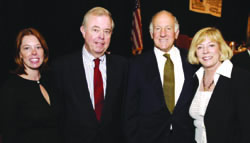

A year of coping ends with new hope for stable court fundingBy Ronald M. George
This year began with uncertainty for much of state government. Following an unprecedented recall election, an unprecedented fiscal crisis kept us unsure of where the judicial branch would be as we began this latest fiscal year. Mean-while, our quest for establishing predictable, adequate funding for courts statewide has acquired more and more urgency. The demands and expectations placed on the judicial branch have greatly expanded as the diversity and complexity of our state has grown. The start of the latest budget cycle was not promising. As has been the custom, and taking into account the difficult fiscal picture, we developed a budget for the courts based on documented needs, but Gov. Schwarzenegger’s proposed budget to the legislature would have resulted in severe reductions in court operations. During the ensuing months, we held numerous meetings and negotiations with the governor, legislators and staff and, as a result, the May budget revision, as passed, included almost $100 million in additional funding for the judicial branch. The final trial court budget amounted to $2.31 billion — a 4.4 percent increase over the prior year and part of an overall 16 percent increase in trial court funding since fiscal year 2000-2001. The bottom line in dollars and cents for the current fiscal year is a budget that still does not meet all the needs of our branch — but one that allows courts to maintain services for the public at a reasonable level. Some courts have reduced hours of service and cut back certain programs, but by and large, courts have been able to cope. Two legislators — Sens. Joe Dunn and Dick Ackerman — were of tremendous help in advocating for the judicial branch. They come from different sides of the aisle, but were united in their strong support for an adequately funded judicial branch. They spread the word not only to other legislators, but also to the public and community groups through hearings around the state. The State Bar was an active partner in making presentations at these hearings. One particularly striking presentation was a joint effort. The first speaker was a CASA worker — a court-appointed special advocate — who told the story of meeting a 16-year old girl in juvenile hall who was trying to provide her younger siblings with the stability their parents could not, but who had succumbed to the drug and alcohol abuse learned from those same parents. This young woman had made remarkable progress, beating her addiction, finishing high school, going on for more education and returning as a counselor to the drug rehabilitation center that had helped her. The former client then began to read a prepared statement on what the CASA volunteer had done for her. She soon lost her composure — as did many others in the room — as she explained in direct words how the volunteer’s support and belief in her had changed her life. The recent budget cycle involved more than successful advocacy to restore judicial branch resources to a manageable level. A budget trailer bill provides an automatic adjustment to the base funding for trial court operating costs in each new budget year. In addition, our proposed budget for the trial courts will be submitted concurrently to both the legislature and the governor, not just the governor alone. This may sound highly technical, but it represents a sea change in our branch’s relationship with its sister branches. The judiciary’s budget no longer will be treated as that of just another state agency, but instead will be accorded the deference and consideration due an equal branch of government. This does not mean that the courts will have free rein to demand increases. Far from it. The process contemplated is a collaborative one, in which the judicial branch has the responsibility to carefully and completely justify its budget requests. But changes in judicial branch governance during the past several years have made that a far easier task. These modifications ultimately benefit the judicial branch, the state and the public at large by establishing responsible — and responsive — growth. As a result of the revised budget structure, we anticipate a new era of predictable and stable funding, equal funding across the state and adequate funding to permit quality operations to meet the public’s needs. • This column is adapted from the chief justice’s State of the Judiciary Address during the State Bar’s Annual Meeting last month. The chief justice’s complete remarks are available at courtinfo.ca.gov/reference/soj100904.htm. |
||||||||
|
||||||||
